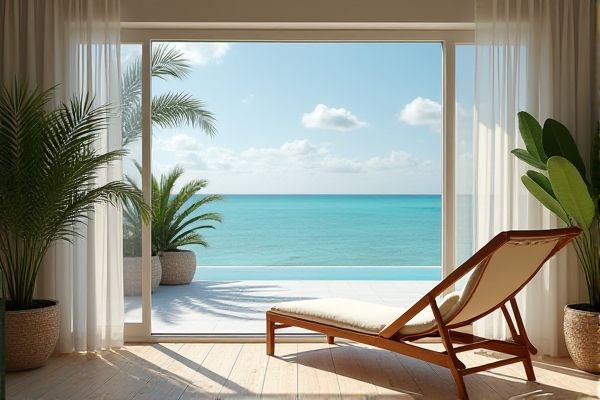
A sun lounger is designed primarily for outdoor sunbathing with adjustable backrests and lightweight frames, while a chaise lounge offers more elegant, versatile seating that fits both indoor and outdoor settings with cushioned comfort. Discover which option best suits Your relaxation needs by exploring the detailed differences in the rest of the article.
Table of Comparison
| Feature | Sun Lounger | Chaise Lounge |
|---|---|---|
| Design | Flat, adjustable backrest for lying down | Curved, ergonomic shape for reclining |
| Primary Use | Outdoor sunbathing and relaxation | Indoor/outdoor reclining and seating |
| Material | Weather-resistant materials: aluminum, plastic, rattan | Wood, metal, upholstered fabric |
| Portability | Often lightweight and foldable | Generally heavier and less portable |
| Adjustability | Multiple reclining positions | Limited or no reclining adjustment |
| Comfort | Designed for extended lying down | Focus on ergonomic seating posture |
| Common Locations | Poolsides, beaches, patios | Living rooms, sunrooms, patios |
| Price Range | Affordable to mid-range | Mid-range to premium |
Introduction: Sun Lounger vs Chaise Lounge
Sun loungers and chaise lounges both offer comfortable outdoor seating but differ in design and function. Sun loungers are typically adjustable with a reclining backrest ideal for sunbathing, while chaise lounges often feature a fixed back and stylish upholstery suited for elegant patio settings. Choosing the right one depends on your outdoor space needs and desired comfort level.
Definition of Sun Lounger
A sun lounger is a portable outdoor chair designed specifically for reclining and sunbathing, typically equipped with adjustable backrests that allow you to lie flat or sit upright. It often features materials like weather-resistant mesh, aluminum, or wood to withstand outdoor conditions. Unlike a chaise lounge, which is more of a stationary, upholstered piece for indoor or patio use, a sun lounger emphasizes mobility and sun exposure comfort.
Definition of Chaise Lounge
A chaise lounge is an upholstered chair designed for reclining, featuring an extended seat that supports the legs, often with a backrest that may be adjustable or fixed. Unlike a sun lounger, which is typically outdoor furniture made from materials like metal or plastic and meant primarily for sunbathing, a chaise lounge emphasizes comfort and style, commonly used indoors in living rooms or bedrooms. Its design combines the functions of a chair and a daybed, providing both seating and a place to relax or rest.
Key Differences Between Sun Lounger and Chaise Lounge
Sun loungers are specifically designed for outdoor use with adjustable reclining positions and weather-resistant materials, ideal for sunbathing and poolside relaxation. Chaise lounges typically feature upholstered cushions and a more elegant design suited for indoor or patio settings, emphasizing comfort and style. Your choice depends on whether you prioritize durability and sun exposure or cushioned comfort and aesthetic appeal.
Material Comparison: Durability and Comfort
Sun loungers often feature weather-resistant materials like aluminum frames with quick-drying mesh fabric, ensuring durability and comfort for outdoor use. Chaise lounges typically utilize cushioned upholstery with wooden or metal frames that prioritize indoor comfort but may require more maintenance outdoors. Your choice depends on whether you prioritize easy upkeep and prolonged exposure to elements (sun lounger) or plush comfort with stylistic versatility (chaise lounge).
Design and Style Variations
Sun loungers typically feature adjustable backs and a streamlined, minimalist design that prioritizes functionality and comfort for outdoor use. Chaise lounges often showcase more elaborate frames with cushioned upholstery and decorative elements, blending indoor luxury with outdoor relaxation. The design variations cater to different settings, with sun loungers excelling in poolside practicality and chaise lounges enhancing patio aesthetics.
Outdoor vs Indoor Use Cases
Sun loungers are specifically designed for outdoor use, featuring weather-resistant materials like aluminum, synthetic wicker, or treated wood that withstand sun exposure, rain, and humidity, making them ideal for poolside or garden relaxation. Chaise lounges, while sometimes used outdoors, are typically crafted with indoor comfort and style in mind, using fabrics and designs that complement living rooms, bedrooms, or enclosed patios. Your choice between the two should consider durability demands and environmental conditions to ensure optimal comfort and longevity.
Ergonomics and Comfort Features
Sun loungers are designed with adjustable backrests that allow you to recline fully or partially, promoting optimal ergonomic support for extended sunbathing sessions. Chaise lounges often feature contoured cushions and armrests that enhance comfort by supporting natural body curves and reducing pressure points. Your choice between the two should consider the balance between personalized adjustability and plush relaxation features tailored to your comfort needs.
Maintenance and Care
Sun loungers typically require regular cleaning and occasional oiling or treatment if made of wood, while metal and plastic variants need minimal upkeep with just wiping down to prevent rust or fading. Chaise lounges, often upholstered, demand more frequent fabric care such as vacuuming, spot cleaning, and sometimes professional cleaning to maintain the fabric's appearance and durability. Your choice between sun lounger vs chaise lounge should consider the maintenance effort you're willing to invest to ensure long-lasting comfort and aesthetic appeal.
Which One Should You Choose?
Choosing between a sun lounger and a chaise lounge depends on your outdoor relaxation needs and space availability. Sun loungers are designed for lying flat, offering adjustable positions ideal for sunbathing and poolside comfort, while chaise lounges provide a more upright seating option with cushioned support, perfect for reading or casual seating. Your decision should consider factors like desired comfort, usage, and how the furniture complements your outdoor environment.
 homyna.com
homyna.com